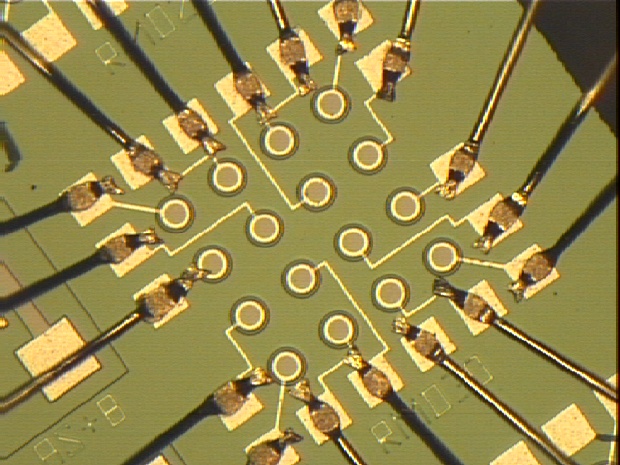
APOLLO APD Detector
The APOLLO detector is an integrated array of avalanche photodiodes (APDs) as shown in the picture below.

The array pictured above (fabricated at MIT Lincoln Laboratories) has 16 elements in a 4×4 square array, on 100 µm centers, and (in this case) 30 µm active area diameters. The silicon substrate is thinned to about 25 µm, resulting in a very low (25 V) breakdown. The elements must be spaced apart in this way to eliminate crosstalk--an avalanche in one element causing an avalance in the adjacent element. But full fill-factor may be recovered by use of a lenslet array.
The small geometry of these devices leads to very good timing performance. So far, we have seen jitter performance as low as 30 ps RMS.
For APOLLO, the APD array enables simultaneous measurement of multiple photons returning from the moon. Throughput estimates for APOLLO predict a mean photon return rate as high as 5 photons per pulse. This is orders-of-magnitude higher than the rates experienced at current LLR stations. The only other LLR facility in the U.S. is at McDonald Observatory, where a combination of small aperture and poor optical performance limits photon return rates to 0.002 photons per pulse (one photon every 500 shots, or about one per minute). Even a rate as high as 0.5 photons per pulse would lead to strong biases if using a single-element single-photon detector.
By spreading the (point-source) return from the moon across multiple elements, we are providing multiple "buckets" for the multiple photons. Another huge advantage of this scheme is that we preserve spatial information in the imaging array such that we will be able to perform real-time guiding on the signal. That is to say, if the telescope begins to drift, we will immediately see the return flux drifting off to one side, and will be able to correct for this without directional ambiguity. If one looses signal on a single-element detector due to pointing error, one has no information on which direction the signal has drifted.